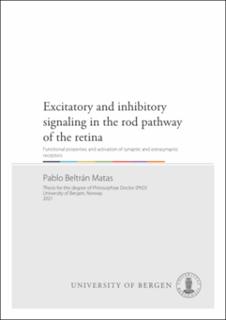| dc.contributor.author | Beltrán Matas, Pablo | |
| dc.date.accessioned | 2023-02-16T12:29:55Z | |
| dc.date.issued | 2021-01-29 | |
| dc.date.submitted | 2021-02-03T00:43:19Z | |
| dc.identifier | container/e0/8e/2a/56/e08e2a56-cfc5-4c91-a544-00eafe31a892 | |
| dc.identifier.isbn | 9788230868355 | |
| dc.identifier.isbn | 9788230864296 | |
| dc.identifier.uri | https://hdl.handle.net/11250/3051498 | |
| dc.description.abstract | The visual system is arguably one of the most complex and studied sensory systems. The processing of visual information starts in the retina, where photoreceptors transduce light stimuli (photons) to electrochemical signals that are then transferred to bipolar cells grouped in different pathways. In the mammalian retina, vision under dim light conditions is mediated by the rod pathway. Glutamatergic rod bipolar cells are presynaptic to two inhibitory interneurons: the AII and A17 amacrine cells. The narrow-field glycinergic AII amacrine transfers rod signals to ON- and OFF-cone bipolar cells via electrical and chemical synapses, respectively. The wide-field GABAergic A17 amacrine provides inhibitory feedback to rod bipolar cells. The synaptic input to both amacrines is mediated by Ca2+-permeable AMPA receptors. It has been recently demonstrated that these two cells express functional extrasynaptic NMDA receptors, with AII amacrines expressing GluN2B-containing receptors and A17 amacrines GluN2A-containing receptors. Ultrastructural studies reported the presence of inhibitory synaptic inputs from other amacrine cells to both the AII and the A17 amacrines. However, the activation and contribution to signal processing of the different receptors that mediate these excitatory and inhibitory inputs is not well understood.
In this thesis, we combined electrophysiological and pharmacological approaches to characterize these receptors and investigate the conditions required for their activation on AII and A17 amacrine cells. Pre-incubation of retinal tissue in either bafilomycin A1 (an inhibitor of neurotransmitter uptake into synaptic vesicles) or L-methionine-sulfoximine (a glutamine synthetase inhibitor) abolished NMDA receptor activation on AII amacrines, but not on A17 amacrines. This suggests a neuronal origin for the glutamate that activates NMDA receptors on AII amacrines and a glial source in the case of A17 amacrine cells. Degradation of endogenous D-serine by DAAO (the enzyme that breaks down D-serine) reduced NMDA activation on AII amacrines, but not on A17 amacrine cells, suggesting that D-serine could be the endogenous co-agonist at NMDA receptors on AII amacrines, but not on A17 amacrine cells.
We also performed a detailed analysis of the kinetics of synaptic and extrasynaptic GABA receptors on these two cells. We found spontaneous inhibitory postsynaptic currents on A17 amacrine cells that displayed fast decay kinetics (τw ~14 ms). Pharmacological investigations suggest that these events are mediated by GABAA receptors that are likely to be composed α1βγ2 subunits. However, we did not observe GABAergic synaptic currents on AII amacrines. Application of brief pulses of GABA (3 mM) to outside-out and nucleated patches from A17 and AII amacrines, respectively, evoked GABAA receptor-mediated responses with relatively slow decay kinetics (τw 42 ms on A17; τw 163 on AII). The use of pharmacological agents suggest that these receptors are likely to be composed of α2,3βγ2 subunits on both amacrine cells.
The major contribution of the studies outlined in this thesis are that (1) different sources of glutamate and potentially different endogenous co-agonists activate the different extrasynaptic NMDA receptor populations on AII and A17 amacrine cells. This suggests a differential contribution of glutamate inputs to excitability and signaling in these cells. (2) A17 amacrine cells receive synaptic GABAergic input mediated by receptors with fast kinetics that could be involved in shunting of excitatory transmission. (3) Both AII and A17 amacrine cells express somatic GABAA receptors with relatively slow kinetics that could mediate signals that allow for temporal summation of inhibitory inputs with a low frequency. | en_US |
| dc.language.iso | eng | en_US |
| dc.publisher | The University of Bergen | en_US |
| dc.relation.haspart | Paper I: Pablo Beltran-Matas, Espen Hartveit, Margaret L. Veruki. Different glutamate sources and endogenous co-agonists activate extrasynaptic NMDA receptors on amacrine cells of the rod pathway microcircuit. European Journal of Neuroscience. 2021, 54(2):4456-4474. The article is available at: <a href="https://hdl.handle.net/11250/2767701" target="blank">https://hdl.handle.net/11250/2767701</a> | en_US |
| dc.relation.haspart | Paper II: Pablo Beltran-Matas, Aurea Castilho, Barbora Tencerova, Margaret L. Veruki, Espen Hartveit. Inhibitory inputs to an inhibitory interneuron: Spontaneous postsynaptic currents and GABA_A receptors of A17 amacrine cells in the rat retina. European Journal of Neuroscience. 2022, 55(6):1442-1470. The article is available at: <a href="https://hdl.handle.net/11250/2997467" target="blank">https://hdl.handle.net/11250/2997467</a> | en_US |
| dc.relation.haspart | Paper III: Pablo Beltran-Matas, Espen Hartveit, Margaret L. Veruki. Functional properties of GABAA receptors on AII amacrine cells of the rat retina. The article is not available in BORA. | en_US |
| dc.rights | In copyright | |
| dc.rights.uri | http://rightsstatements.org/page/InC/1.0/ | |
| dc.title | Excitatory and inhibitory signaling in the rod pathway of the retina: Functional properties and activation of synaptic and extrasynaptic receptors | en_US |
| dc.type | Doctoral thesis | en_US |
| dc.date.updated | 2021-02-03T00:43:19Z | |
| dc.rights.holder | Copyright the Author. All rights reserved | en_US |
| dc.contributor.orcid | https://orcid.org/0000-0003-3817-5095 | |
| dc.description.degree | Doktorgradsavhandling | |
| fs.unitcode | 13-14-0 | |
| dc.date.embargoenddate | 2023-01-29 | |
